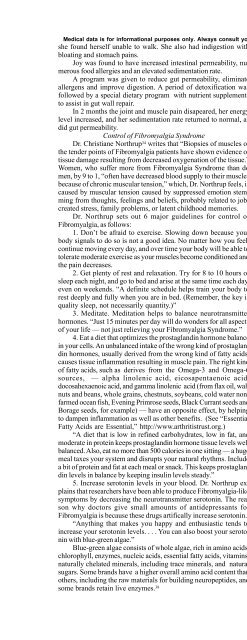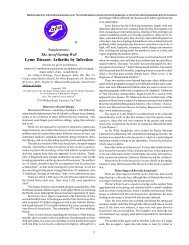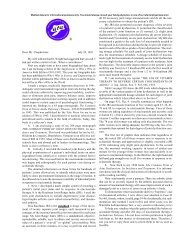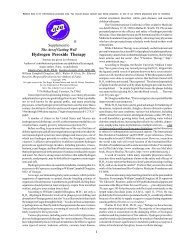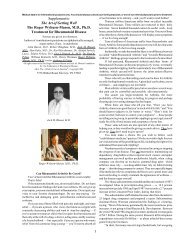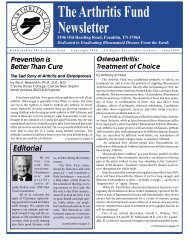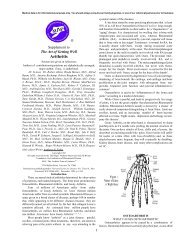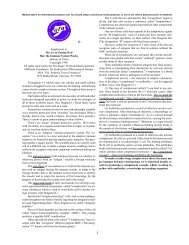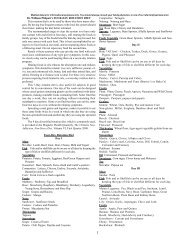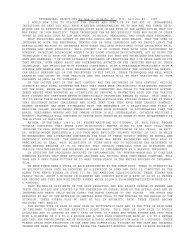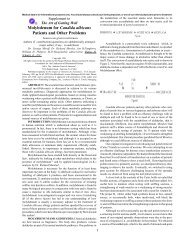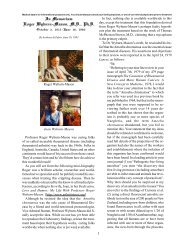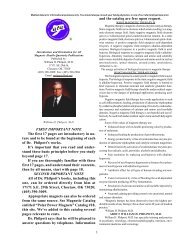Soft Tissue Arthritis Supplement - PDF - Arthritis Trust of America
Soft Tissue Arthritis Supplement - PDF - Arthritis Trust of America
Soft Tissue Arthritis Supplement - PDF - Arthritis Trust of America
You also want an ePaper? Increase the reach of your titles
YUMPU automatically turns print PDFs into web optimized ePapers that Google loves.
Medical data is for informational purposes only. Always consult your family physician, or one <strong>of</strong> our referral physicians prior to treatment.<br />
she found herself unable to walk. She also had indigestion with<br />
bloating and stomach pains.<br />
Joy was found to have increased intestinal permeability, numerous<br />
food allergies and an elevated sedimentation rate.<br />
A program was given to reduce gut permeability, eliminate<br />
allergens and improve digestion. A period <strong>of</strong> detoxification was<br />
followed by a special dietary program with nutrient supplements<br />
to assist in gut wall repair.<br />
In 2 months the joint and muscle pain disapeared, her energy<br />
level increased, and her sedimentation rate returned to normal, as<br />
did gut permeability.<br />
Control <strong>of</strong> Fibromyalgia Syndrome<br />
Dr. Christiane Northrup 34 writes that “Biopsies <strong>of</strong> muscles <strong>of</strong><br />
the tender points <strong>of</strong> Fibromyalgia patients have shown evidence <strong>of</strong><br />
tissue damage resulting from decreased oxygenation <strong>of</strong> the tissue.”<br />
Women, who suffer more from Fibromyalgia Syndrome than do<br />
men, by 9 to 1, “<strong>of</strong>ten have decreased blood supply to their muscles<br />
because <strong>of</strong> chronic muscular tension,” which, Dr. Northrup feels, is<br />
caused by muscular tension caused by suppressed emotion stemming<br />
from thoughts, feelings and beliefs, probably related to jobcreated<br />
stress, family problems, or latent childhood memories.<br />
Dr. Northrup sets out 6 major guidelines for control <strong>of</strong><br />
Fibromyalgia, as follows:<br />
1. Don’t be afraid to exercise. Slowing down because your<br />
body signals to do so is not a good idea. No matter how you feel,<br />
continue moving every day, and over time your body will be able to<br />
tolerate moderate exercise as your muscles become conditioned and<br />
the pain decreases.<br />
2. Get plenty <strong>of</strong> rest and relaxation. Try for 8 to 10 hours <strong>of</strong><br />
sleep each night, and go to bed and arise at the same time each day,<br />
even on weekends. “A definite schedule helps train your body to<br />
rest deeply and fully when you are in bed. (Remember, the key is<br />
quality sleep, not necessarily quantity.)”<br />
3. Meditate. Meditation helps to balance neurotransmitter<br />
hormones. “Just 15 minutes per day will do wonders for all aspects<br />
<strong>of</strong> your life — not just relieving your Fibromyalgia Syndrome.”<br />
4. Eat a diet that optimizes the prostaglandin hormone balance<br />
in your cells. An unbalanced intake <strong>of</strong> the wrong kind <strong>of</strong> prostaglandin<br />
hormones, usually derived from the wrong kind <strong>of</strong> fatty acids,<br />
causes tissue inflammation resulting in muscle pain. The right kind<br />
<strong>of</strong> fatty acids, such as derives from the Omega-3 and Omega-6<br />
sources, — alpha linolenic acid, eicosapentaenoic acid,<br />
docosahexaenoic acid, and gamma linolenic acid (from flax oil, walnuts<br />
and beans, whole grains, chestnuts, soybeans, cold water nonfarmed<br />
ocean fish, Evening Primrose seeds, Black Currant seeds and<br />
Borage seeds, for example) — have an opposite effect, by helping<br />
to dampen inflammation as well as other benefits. (See “Essential<br />
Fatty Acids are Essential,” http://www.arthritistrust.org.)<br />
“A diet that is low in refined carbohydrates, low in fat, and<br />
moderate in protein keeps prostaglandin hormone tissue levels well<br />
balanced. Also, eat no more than 500 calories in one sitting — a huge<br />
meal taxes your system and disrupts your natural rhythms. Include<br />
a bit <strong>of</strong> protein and fat at each meal or snack. This keeps prostaglandin<br />
levels in balance by keeping insulin levels steady.”<br />
5. Increase serotonin levels in your blood. Dr. Northrup explains<br />
that researchers have been able to produce Fibromyalgia-like<br />
symptoms by decreasing the neurotransmitter serotonin. The reason<br />
why doctors give small amounts <strong>of</strong> antidepressants for<br />
Fibromyalgia is because these drugs artifically increase serotonin.<br />
“Anything that makes you happy and enthusiastic tends to<br />
increase your serotonin levels. . . . You can also boost your serotonin<br />
with blue-green algae.”<br />
Blue-green algae consists <strong>of</strong> whole algae, rich in amino acids,<br />
chlorophyll, enzymes, nucleic acids, essential fatty acids, vitamins,<br />
naturally chelated minerals, including trace minerals, and natural<br />
sugars. Some brands have a higher overall amino acid content than<br />
others, including the raw materials for building neuropeptides, and<br />
some brands retain live enzymes. 38<br />
9<br />
Dr.Northrup feels that it is important to take these supplements<br />
“in a progressive and regular pattern,” and she <strong>of</strong>fers the<br />
following regimen:<br />
Week One: Take two digestive enzyme capsules with<br />
blue-green algae just before breakfast and lunch. Also, take two<br />
acidophilus capsules with algae each morning 30 minutes before<br />
eating. (“Friendly Bacteria -- Lactobacillus acidophilus & Bifido<br />
bacterium,” http://www.arthritistrust.org.)<br />
Week Two: Add blue-green algae at breakfast each day.<br />
Week Three: Stay with the enzymes and acidophilus, but<br />
begin increasing your algae intake to 2-5 capsules three times per<br />
day with meals. (See “Systemic Enzyme Therapy,” http://<br />
www.arthritistrust.org.)<br />
Week Four: Continue to experiment with the amount <strong>of</strong><br />
algae you need. Some people get very good results with just a little,<br />
while others require a heftier intake.<br />
6. Take supplements. Dr. Northrup states that “Magnesium,<br />
malic acid, manganese, and the B vitamins have all been shown to<br />
decrease pain in Fibromyalgia Syndrome patients. Magnesium and<br />
malic acid help the body synthesize energy and strengthen cell<br />
membranes, thus preventing microtrauma to the muscles. They also<br />
help with aluminum detoxification (excess aluminum may be implicated<br />
in Fibromyalgia Syndrome, but results are inconclusive as <strong>of</strong><br />
yet). (See “Magnesium Chloride HexahydrateTherapy,” http://<br />
www.arthritistrust.org.)<br />
“Take a total <strong>of</strong> 300-600 mg <strong>of</strong> magnesium daily, either in your<br />
multivitamin/mineral supplement or separately.<br />
“For malic acid, start with 1,200 mg per day in divided doses<br />
with meals. You can gradually increase to 2,400 mg per day if you<br />
experience no pain relief within the first two weeks.<br />
“The B vitamins support cell wall healing and most other<br />
metabolic functions”: 100 mg each <strong>of</strong> the B’s.<br />
“Manganese is a necessary co-factor in the production <strong>of</strong> neurotransmitters”:<br />
10-20 mg <strong>of</strong> manganese.<br />
Dr. Northrup says that she routinely has good results in 3 to 6<br />
weeks when she places her Fibromyalgia patients on the above<br />
regimen. 34<br />
Diet and Nutritional <strong>Supplement</strong>s<br />
Modified Cave Man Diet<br />
Consistent with Dr. Christiane Northrup’s regimen, consider<br />
use <strong>of</strong> the diet described in <strong>Arthritis</strong>: Osteoarthritis and Rheumatoid<br />
Disease Including Rheumatoid <strong>Arthritis</strong>, “The Perfect Plan for<br />
Perfect Health,” “Proper Nutrition for Rheumatoid <strong>Arthritis</strong>,<br />
“Lonsdale Diet: Why I Left Orthodox Medicine,” (http://<br />
www.arthritistrust.org). Most healthy diets remind us that fresh<br />
fruits, vegetables, whole grains, nuts and cold-water fish is closer to<br />
our caveman ancestors’ diets, and also the diet that followed man’s<br />
evolution. Modify this diet according to your doctor’s instructions.<br />
Eat foods high in magnesium: dark leafy greens, and green and yellow<br />
vegetables. 4<br />
Zoltan Rona, M.D., M.Sc. 35 was asked by a 33-year-old mother<br />
<strong>of</strong> three children for advice. She explained that she was on Tylenol ®<br />
3 (with codeine), Demerol ® , Diauldid ® , Prozac ® , Immovane ® , Diazepam<br />
® , and Sinequain ® . She wanted to know if she could do anything<br />
healthier.<br />
Dr. Rona’s reply was, “The number and combination <strong>of</strong> drugs<br />
you are taking is alarming. Your first order <strong>of</strong> business should be to<br />
wean <strong>of</strong>f the drugs with the help <strong>of</strong> a drug detoxification centre.<br />
Once this is accomplished look into natural approaches to treatment.<br />
(See “Allergies and Biodetoxification for the Arthritic,” http:/<br />
/www.arthritistrust.org.)<br />
“Foods that should be reduced are refined carbohydrates (sugar<br />
and white flour products) and animal fats (especially those found in<br />
red meats).”<br />
Dr. Rona also advised taking the correct kind <strong>of</strong> essential fatty<br />
acids, similar to advice already described above by Dr. Christaine


